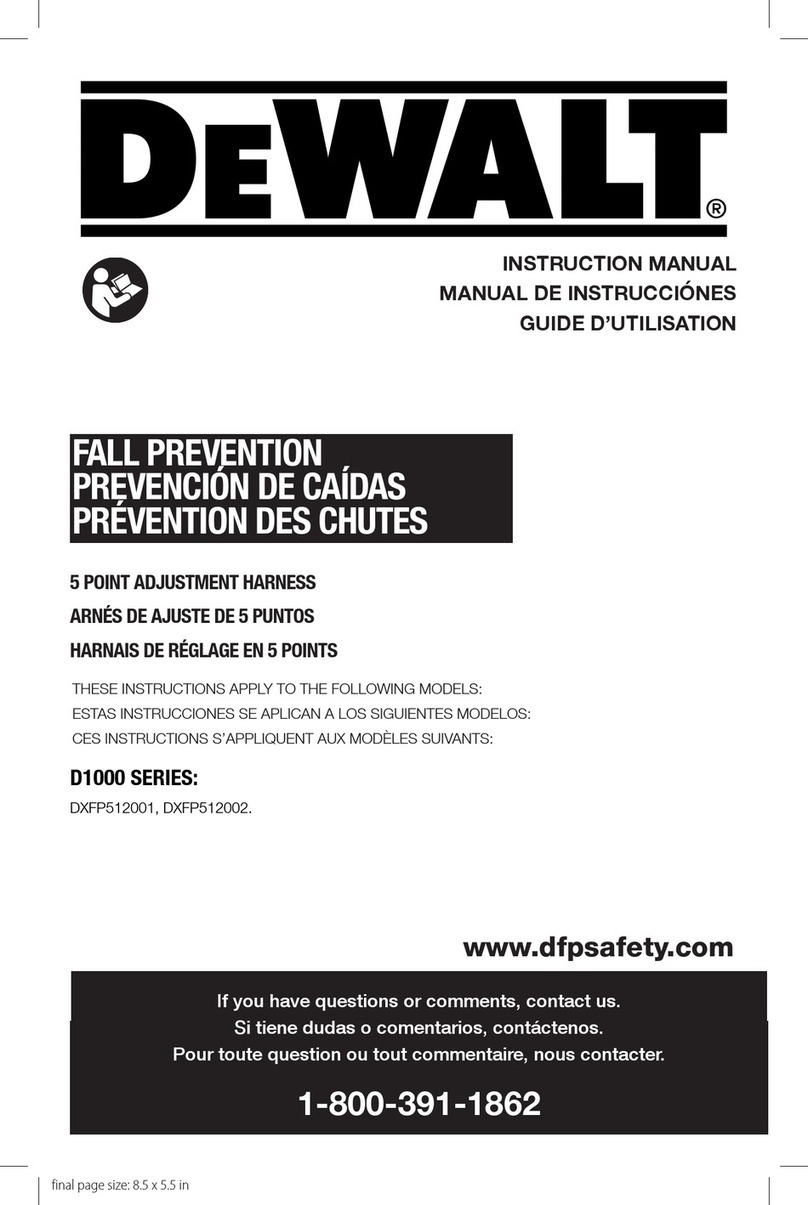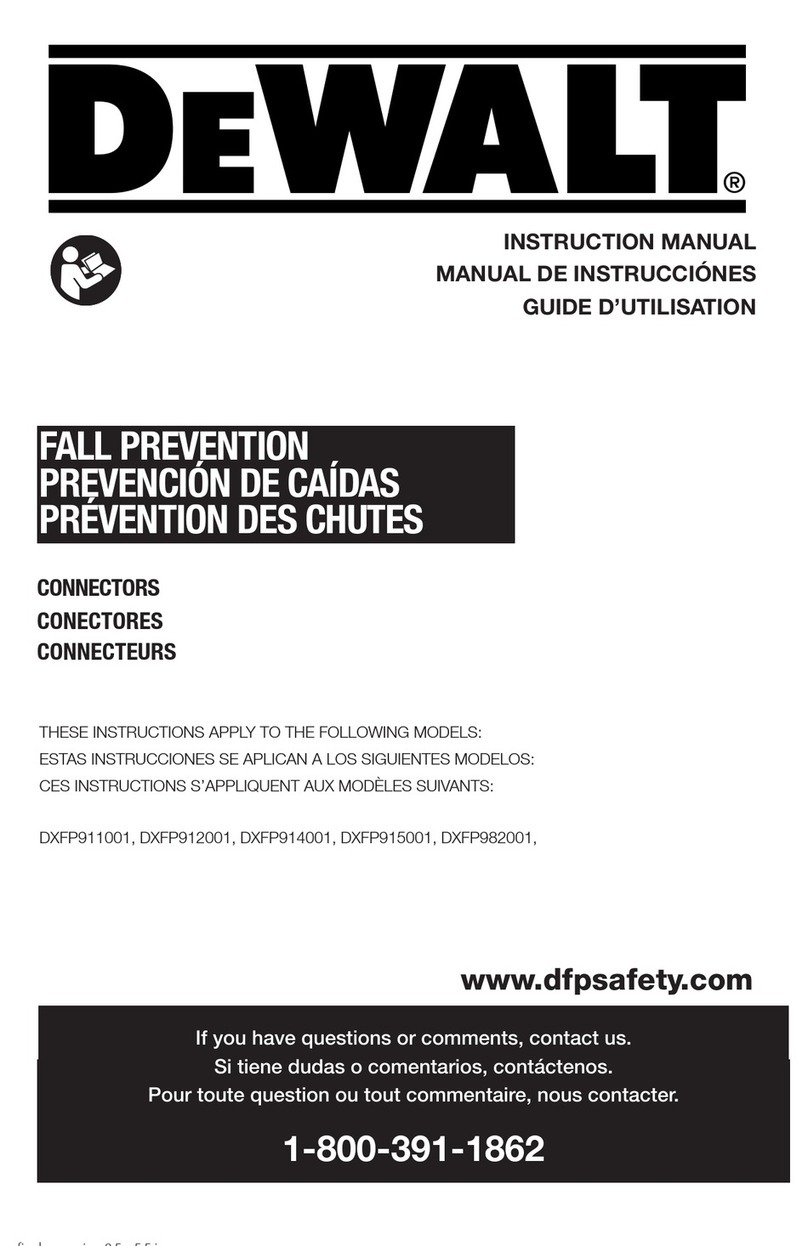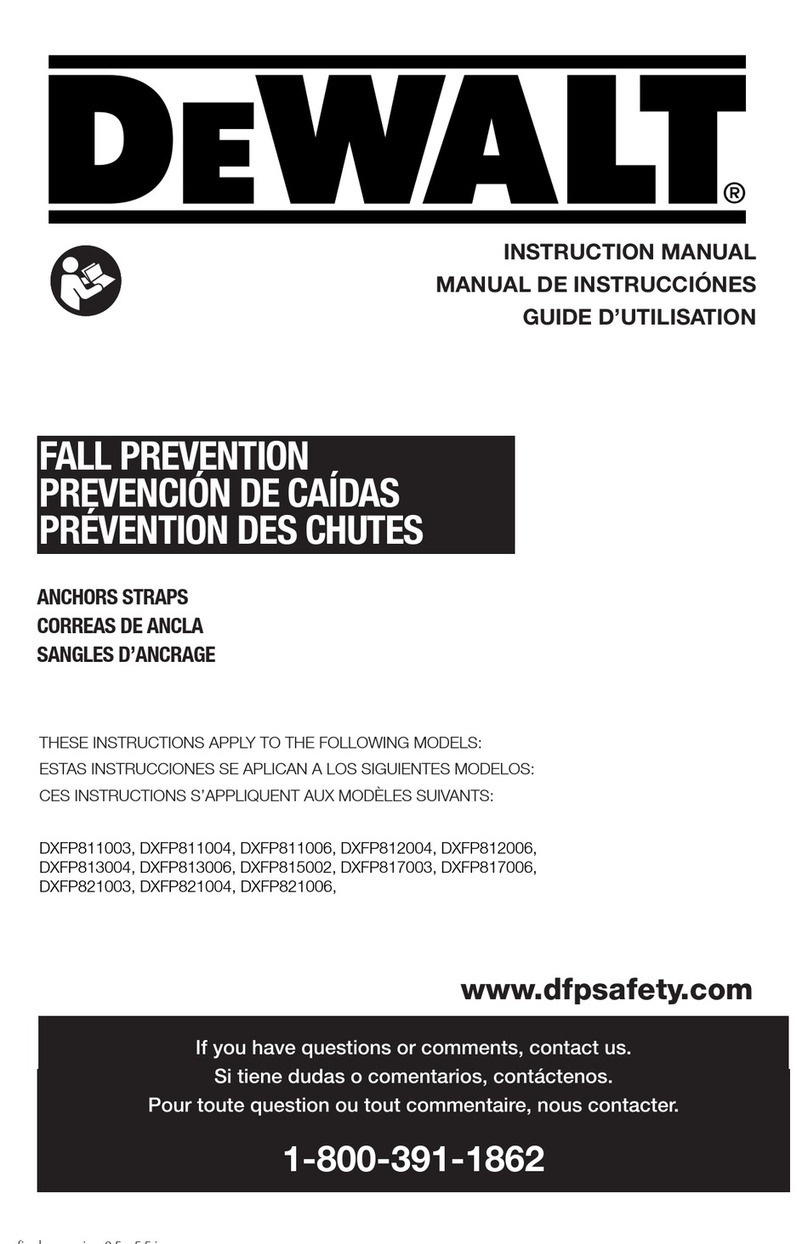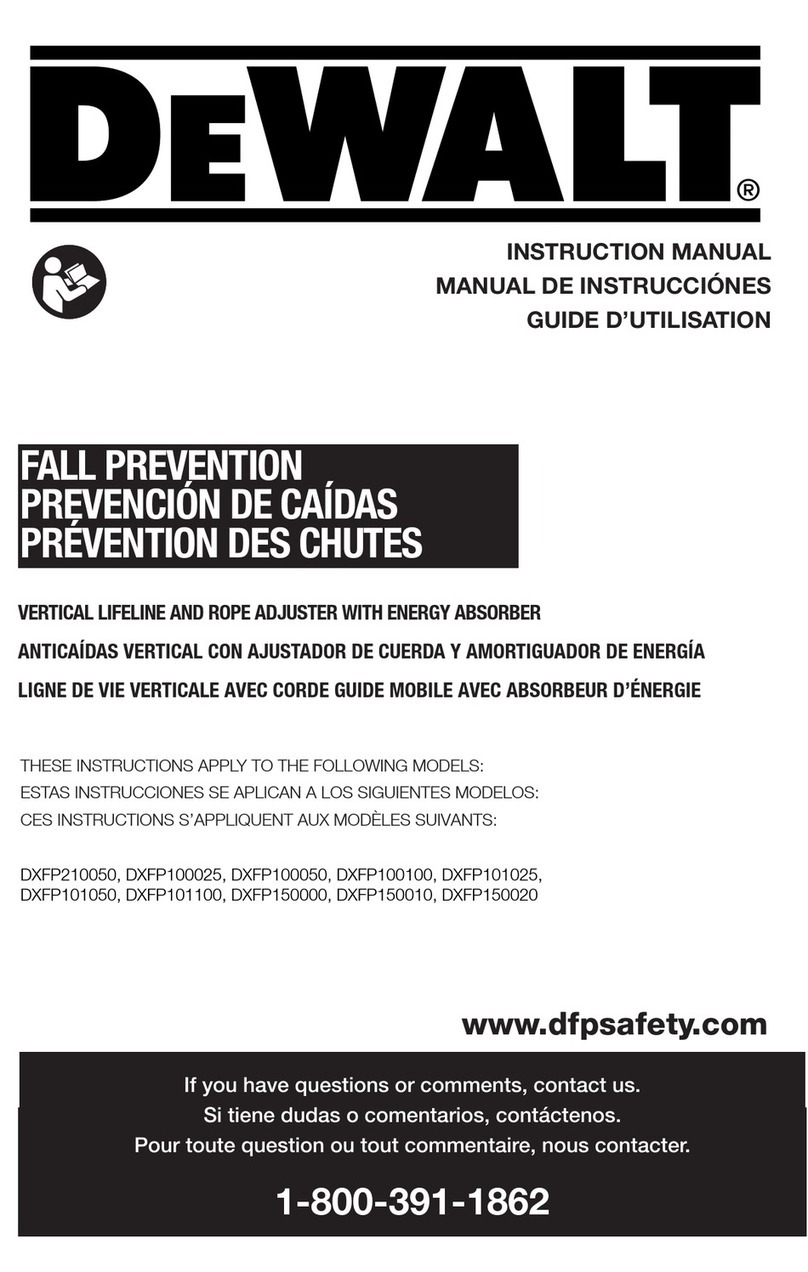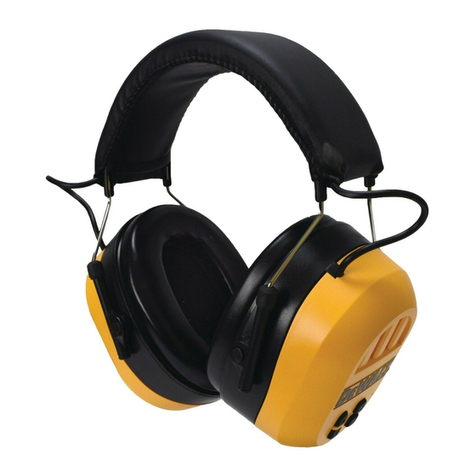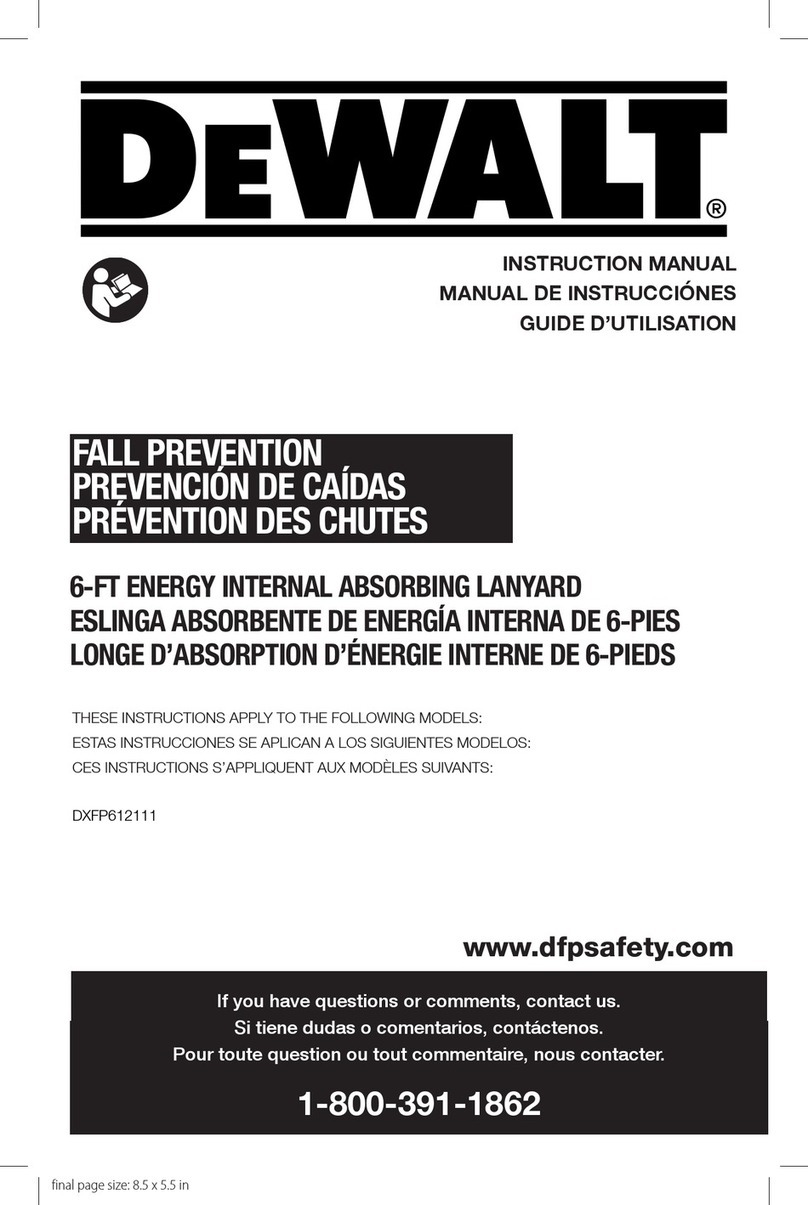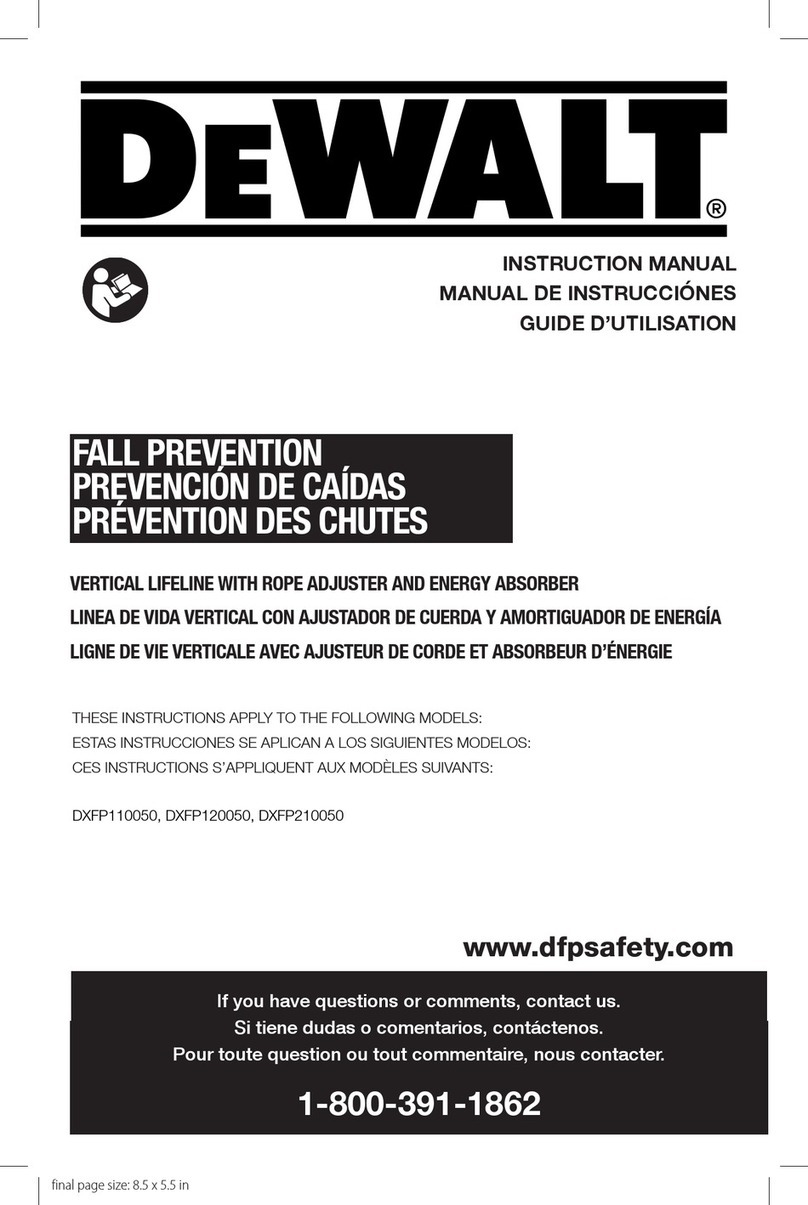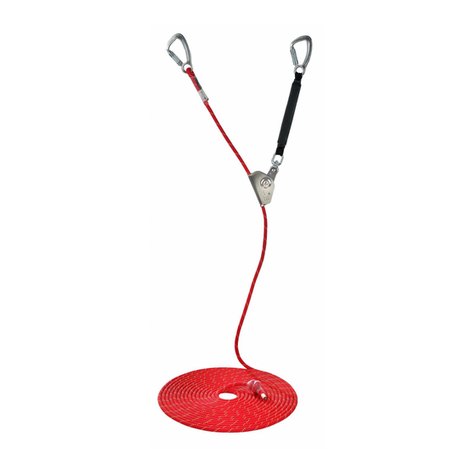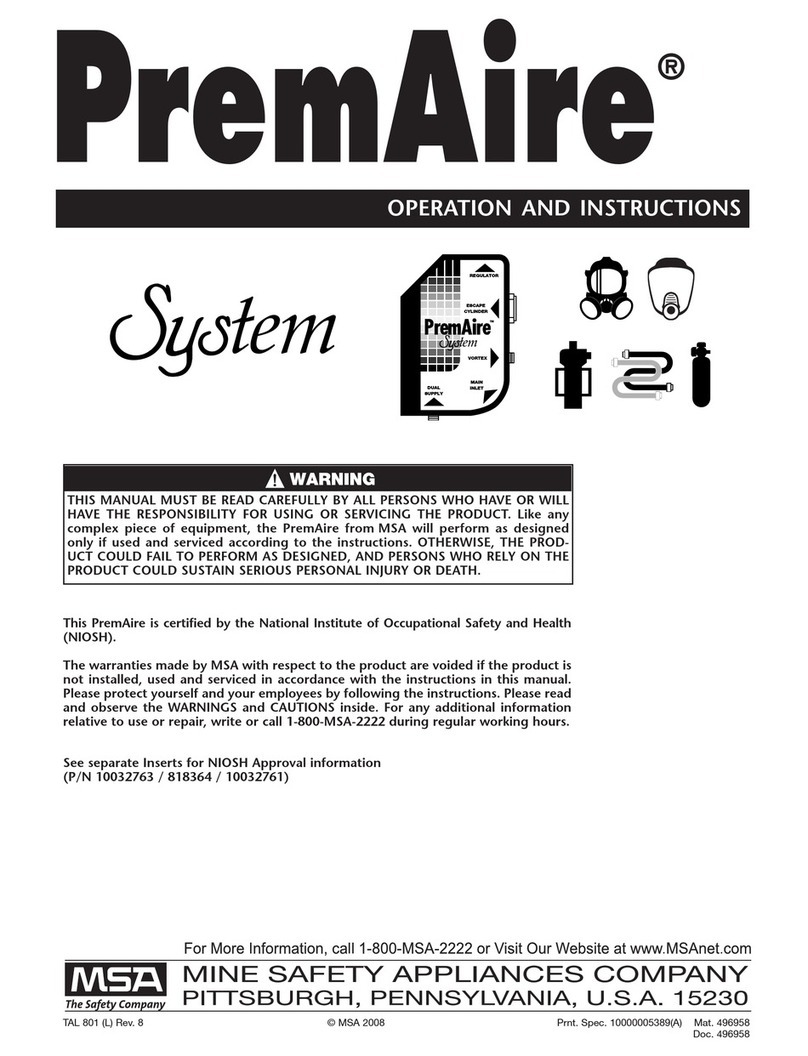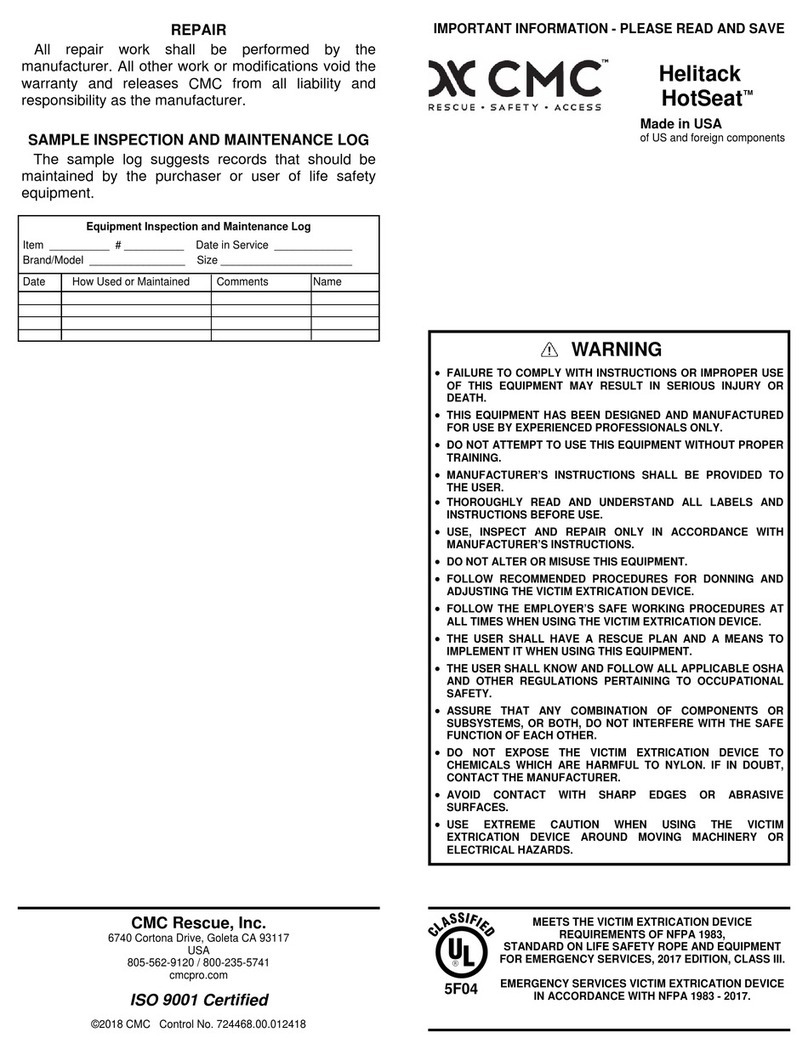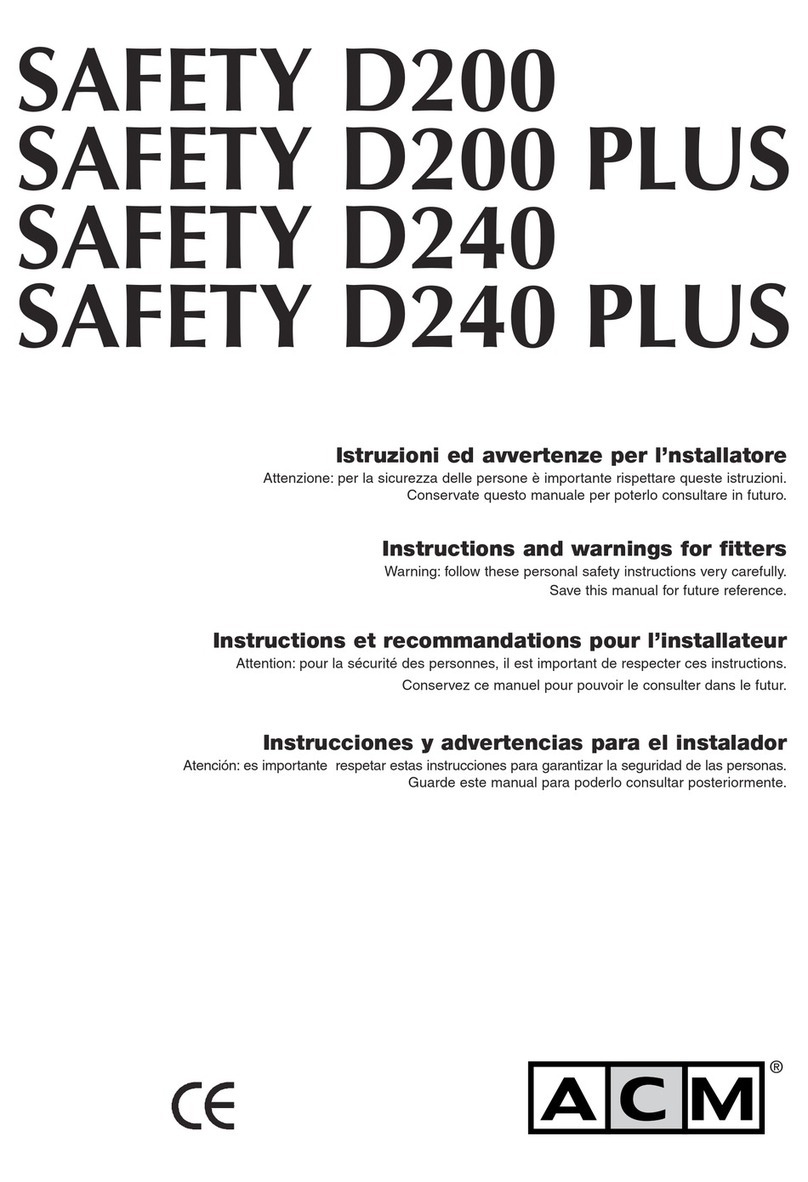DeWalt DXFP841001 User manual

MANUAL DE INSTRUCCIÓNES
INSTRUCTION MANUAL
GUIDE D’UTILISATION
1-800-391-1862
www.dfpsafety.com
If you have questions or comments, contact us.
Si tiene dudas o comentarios, contáctenos.
Pour toute question ou tout commentaire, nous contacter.
THESE INSTRUCTIONS APPLY TO THE FOLLOWING MODELS:
ESTAS INSTRUCCIONES SE APLICAN A LOS SIGUIENTES MODELOS:
CES INSTRUCTIONS S’APPLIQUENT AUX MODÈLES SUIVANTS:
DXFP841001, DXFP841002, DXFP843001, DXFP843002, DXFP844001,
DXFP845001, DXFP846000, DXFP846001, DXFP846011, DXFP846101.
FALL PREVENTION
METALLIC ANCHOR
PREVENCIÓN DE CAÍDAS
ANCLAJE METÁLICO
PRÉVENTION DES CHUTES
ANCRAGE MÉTALLIQUE
final page size: 8.5 x 5.5 in

EnglishEnglish
1
English (original instructions)
English (original instructions) 1
Español (traducido de las instrucciones originales) 16
Français (traduction de la notice d’instructions originale) 31
Definitions: Safety Alert Symbols and Words
This instruction manual uses the following safety alert symbols and words to alert you to hazardous situations and your risk of personal injury or
property damage.
DANGER: Indicates an imminently hazardous situation which, if not avoided, will result in death or serious injury.
WARNING: Indicates a potentially hazardous situation which, if not avoided, could result in death or serious injury.
CAUTION: Indicates a potentially hazardous situation which, if not avoided, may result in minor or moderate injury.
(Used without word) Indicates a safety related message.
NOTICE: Indicates a practice not related to personal injury which, if not avoided, may result in property damage.
WARNING: To reduce the risk of injury, read and understand these safety warnings and instructions before using the product. Keep these
instructions for future reference.
WARNING: Read and follow the manufacturer’s instruction for each component of the
system.
WARNING: Do not remove product labels which include important warnings and
information for all authorized users.
WARNING: It is important to inspect the equipment according to the manufacturer’s
instructions before each use. Inspection of equipment should be done at least annually by
a Competent person and the results recorded in the inspection log.
WARNING: DO NOT ALTER THE EQUIPMENT IN ANY WAY.
WARNING: Always have a Rescue Plan ready and at hand when using this equipment.
WARNING: Every individual requires formal training in the use of fall protection
equipment and system.
WARNING: In order to ensure that the user is familiar with the instructions provided
in this manual, it becomes the responsibility of the user to undergo proper training on
the proper inspection, use and maintenance of this equipment. It is also the employer’s
responsibility to ensure that all users are trained in proper use, inspection and
maintenance of Fall Protection Equipment.

EnglishEnglish
32
WARNING:
Read all safety warnings,
instructions, illustrations and specications
provided with this product. Failure to follow all
instructions listed below may result in serious injury.
3) WORK AREA SAFETY
2) GENERAL REQUIREMENT
1) PERSONAL SAFETY
WARNING:
Prior to using the equipment, please
record the product identication information found
on the ID label of your Fall arrest equipment record
table of this manual.
a ) It is crucial that the Authorized person/user
of this fall protection equipment reads and
understands these instructions. In addition, it is
the employer's responsibility to ensure that all
users are trained in the proper use, inspection,
and maintenance of fall protection equipment.
b ) Proper use of fall arrest systems can save lives
and reduce the potential of serious injuries from
a fall.
c ) The user must be aware that forces experienced
during the arrest of a fall or prolonged
suspension may cause injury.
d ) Consult a physician if there is any question about
the user's ability to use this product.
e ) Pregnant women and minors must not use this
product.
DANGER: Do not skip this instruction manual.
Alterations or misuse of this product, or failure to follow
instructions may result in serious injury or death.
WARNING:
This product is part of a personal
fall arrest or restraint system. The user must
follow the manufacturer’s instructions for each
component of the system. These instructions must
be provided to the user of this equipment. The user
must understand these instructions before using
this equipment. Manufacturer’s instructions must
be followed for proper use and maintenance of
this product. These instructions are intended to
meet the manufacturer’s instructions as required
by OHSA, ANSI Z359.1-2007, ANSI 10.32-2012
Regulations.
a ) All warnings and instructions shall be provided
to Authorized persons/users.
b ) All Authorized persons/users must refer to the
regulations governing occupational safety, as
well as applicable ANSI standards.
c ) Please refer to product labels for information on
specific OSHA regulations, and ANSI standards
met by the product.
d ) Proper precautions should always be taken to
remove any obstructions, debris, material, or
other recognized hazards from the work area
that could cause injuries or interfere with the
operation of the system.
e ) All equipment must be inspected before each use
according to the manufacturer's instructions.
f ) All equipment should be inspected by a
Competent person on at least an annual basis.
g ) To minimize the potential for accidental disen-
gagement, a Competent person must ensure
system compatibility.
h ) Equipment must not be altered in any way.
Repairs must be performed only by the
manufacturer, or persons or entities authorized
in writing by the manufacturer.
i ) Any product exhibiting deformities, unusual
wear, or deterioration must be immediately
removed from service for inspection by Qualified
person.
j ) Any equipment subject to a fall must be removed
from service.
a ) Keep children and bystanders away while
working. Distractions can cause hazardous
conditions.
b ) The authorized person/user shall have a rescue
plan and the means at hand to implement it
when using this equipment.
c ) All synthetic material must be protected from
slag, hot sparks, open flames, or other heat
sources. The use of heat resistant materials is
recommended in these applications.
d ) Environmental hazards should be considered
when selecting fall protection equipment.
Equipment must not be exposed to chemicals
which may produce a harmful effect.
e ) Polyester should be used in certain chemical or
acidic environments. Use in highly corrosive or
caustic environments dictates a more frequent
inspection and servicing program to ensure the
integrity of the device is maintained.
f ) Do not allow equipment to come in contact
with anything that will damage it including, but
not limited to, sharp, abrasive, rough or high-
temperature surfaces, welding, heat sources,
electrical hazards, or moving machinery.
g ) Always check for obstructions below the work
area to make sure potential fall path is clear.
h ) Allow adequate fall clearance below the work
surface.
i ) Never remove product labels, which include
important warnings and information for the
authorized person/user.
4) IMPORTANT INFORMATION
5) COMPONENT COMPATIBILITY
6) COMPATIBILITY OF CONNECTORS
a ) Component compatibility with
DEWALT
manufactured fall protection equipment is
ensured by strictly following the instructions for
each type of equipment used. However, if the
user utilizes combinations of components or
sub systems that are manufactured by others,
only a “qualified” or “competent” person (as
defined in OSHA) can ensure the compatibility.
If substitutions or replacements are made with
non-approved components or sub systems, then
this may severely affect the compatibility of the
equipment, making the complete system unsafe
for use.
a ) To ensure the compatibility of the connectors
with their connecting element, it is important
to safeguard that the sizes and shapes of
the connectors and the connecting elements
do not allow their gate mechanisms to open
inadvertently, not withstanding their orientation
with each other. All hooks, carabiners, D-rings
and other such connectors must be capable
of supporting a min. force of 5000 lbs. (23
kN). All connectors must be compatible with
all system components like anchorages, etc.
Never use equipment which is not compatible
as this may cause the connectors to disengage
unintentionally. All connectors must be
compatible in shape and size. As per ANSI
Z359.12 and OSHA, only self-locking snap hooks
and carabiners may be used.
a ) Always send the equipment back to the
manufacturer, or to the persons or entities
authorized in writing by the manufacturer, for
any repairs if required. NOT all the equipment is
repairable.
b ) Never use any natural material like manila,
cotton, etc. as part of the Fall Protection System.
c ) Fall protection equipment should only be used
for the purpose for which it has been designed.
d ) This equipment should never be used for towing
and hoisting or for any other purpose than its
intended use.
e ) A competent person must ensure compatibility
of the system to minimize any potential for
accidental disengagement
f ) Users shall be trained on all warnings and
instructions provided in this manual.
g ) It is important for all Qualified, Competent and
users to refer to the applicable ANSI Standards
and to the regulations governing occupational
safety.
h ) It is important to keep in mind environmental
hazards when selecting fall protection
equipment.
i ) Extreme environments may require a more
frequent inspection and servicing program of
the fall protection equipment to maintain the
integrity and safety of the equipment.
7) CONNECTIONS USING CONNECTORS
a ) Ensure that only self-locking snap hooks and
carabiners are used with this equipment. All
connections should be compatible in size, shape
and strength. The connectors used should be
suitable to each application. Ensure that they are
fully closed and locked while in use.
WARNING: The products enumerated in this instruction manual are a part of a personal fall restraint, fall
arrest or rescue system. It is important that the user reads and follows the manufacturer’s instructions for each
component of the system. This manual contains information which is important to the user’s safety and should
be kept in a safe place for future reference as needed. The instructions provided in this manual are meant for the
use of this equipment and should be read thoroughly and understood by the user before the equipment is used.
Manufacturer’s instructions must be properly followed for the correct use and maintenance of this equipment.
Please contact DEWALT for any questions regarding use of this equipment.
WARNING: Fall arrest systems and equipment are life saving products and are designed to reduce the
potential of serious injury in the event of a fall. However, it is important to note that the user may experience an
impact of force on their body in the event of a fall. The victim of a fall may also experience adverse eects due to
prolonged suspension in a Full Body Harness (FBH). In case there is a doubt about the user’s ability to utilize this
product, the user must consult a physician. Pregnant women and minors are not considered t for the use of this
equipment
.

EnglishEnglish
54
8) NEVER USE INAPPROPRIATE
CONNECTIONS
a ) Two or more connectors should never be
attached to a single D-ring.
b ) Never attach a connector that could result in a
load on its gate.
c ) Connectors should not be connected in a false
engagement. It should be visually confirmed
that the connector is fully engaged to the anchor
point. Avoid conditions that allow for features
that protrude from the connectors to catch
on the anchor, giving a false sense of being
connected.
d ) Connectors should not be connected to each
other.
e ) Connectors should not be connected directly to
the webbing or to the rope lanyard or tie back,
unless specifically allowed by the manufacturer.
f ) Connectors should not be connected to any
object which does not allow the connector gate
to close or lock. Anchor shapes that allow roll out
to occur should never be used for connection. If
the anchor, to which the snap hook or carabiner
While using DEWALT snap hooks and
carabiners, they should not be connected as
below:
is attached, is under sized or irregular in shape,
then this may allow for the gate of the connector
to come in contact with the anchor, thereby
causing the connector to open up and possibly
disengage from the anchor. This is known as roll
out of the connector.
WARNING: Large throat opening snap hooks such as scaold or rebar hooks should not be connected to
standard size D-rings or similar objects. The reason for this is if the hook or D-ring twists or rotates, then this may
result in a load on the gate of the connector. Large throat snap hooks are specically designed for use on xed
structure elements such as rebar or cross members. These are shaped in such a way that they cannot capture the
gate of the hook.
9) IMPORTANT RESTRICTIONS WHILE
MAKING CONNECTIONS
a ) A snap hook should not be connected into a loop
or thimble of a wire rope, or attached to it in any
way that may slack the wire rope.
b ) Do not make connections where the connector
locking mechanism can come into contact with
a structural member, or other such equipment,
as it may potentially unlock the connector and
release the connection.
c ) To connect to a single or a pair of soft loops on a
harness, a carabiner that can fully close and lock
should only be used. Snap hooks are not allowed
for such connections, unless specifically allowed
by manufacturer.
d ) A carabiner may be connected to a loop or ring
connector that is already occupied by a choker
style connector. Snap hooks are not allowed for
such connections.
A. B. C.
D. E. F.
WARNING: If the connecting element to which a snap hook (shown) or carabiner attaches is undersized or
irregular in shape, a situation could occur where the connecting element applies a force to the gate of the snap
hook or carabiner. This force may cause the gate (of either a self-locking or a non-locking snap hook) to open,
allowing the snap hook or carabiner to disengage from the connecting point.
Small ring or other
non- compatibly
shaped element
UNINTENTIONAL DISENGAGEMENT (ROLL OUT)
10) CONNECTING SUB SYSTEMS
a ) Use only those connecting subsystems (self-
retracting lifeline, lanyard, rope grab and
lifeline, cable sleeves) that are suitable for your
application.
b ) See subsystems manufacturer's instructions for
more information. Some harness models have
web loop connecting points.
c ) Do not use snap hooks to connect to the web
loop. Use a self-locking carabiner to connect to
a web loop.
d ) Ensure the carabiner cannot cross-gate load
(load against the gate rather than along the
backbone of the carabiner).
11) RESCUE PLAN
a ) A rescue plan should be well documented and in
place before performing work at height.
b ) The rescue operation must be performed by
trained and competent personnel only.
c ) The rescue team exert should supervise the
rescue operation performed.
d ) It is also advised to work in pairs while working
on the site.
12) ENVIRONMENTAL HAZARDS
• Chemicals
• Extreme Temperatures
• Corrosive Environments
• Gases
• High Voltage Power Lines
• Sharp Edges
• Moving Machinery and Vehicles
Environmental hazards may include the following, but
are not limited to:
Please contact DFP Safety for use of this equipment in
the presence of any environmental hazard.
13) ANCHORAGE STRENGTH
The application type determines the anchorage
strength requirement. As per ANSI Z359.1 the necessary
anchorage strength for the following applications is
listed below:
• Fall Arrest: As per OSHA 1926.500 and 1910.66
anchorages that are used for attachment of
Personal Fall Arrest Systems (PFAS) shall be
independent of any anchorage being used to
support or suspend platforms. They should be
capable of withstanding a minimum load of
5000 lbs. (23 kN) per user attached, or should
be designed, installed and used as part of a
complete PFAS which maintains a safety factor
of at least two. Rating of the anchorage should
always be done under the supervision of a
qualified person.

EnglishEnglish
76
• Work Positioning: The structure to which
the work positioning system (WPS) is attached
must be able to sustain a static load of min.
3000 lbs. (13.3 kN), applied in the directions
permitted by the work positioning system. Or, it
should be able to sustain two times the potential
impact load, whichever is greater; see 1926.502.
However, if more than one work positioning
system is attached to an anchorage, then the
strength mentioned above must be multiplied by
the number of WPS attached to the anchorage.
• Restraint: The strength requirement of
anchorages which are selected for restraint
and travel restraint systems is min. of 1000 lbs.
(4.5 kN) static load applied in the directions
permitted by the system. If more than one
restraint and travel restraint system is attached
to anchorage, then the 1000 lbs. shall be
multiplied by the number of systems attached
to the anchorage to determine the min. strength
requirement.
• Rescue: The minimum strength of the
anchorage selected for rescue should be such
that it is capable of sustaining a static load of
min. 3000 lbs. (13.3 kN) applied in the direction
permitted by the system. To determine the
strength requirement of the anchorage if
more than one rescue system is attached, then
multiply 3000 lbs. (13.3 kN) by the number of the
systems attached to the anchorage.
WARNING: This equipment is not designed to be used in high temperature environments. It is important to
protect this equipment when using near activities like welding or metal cutting. Hot sparks may cause damage
to this equipment or burn it. Contact DEWALT with any questions regarding the details on use of this equipment
in high temperature environments.
WARNING:
It is important to take additional precautions while using this equipment in the presence of any
environmental hazards so as to prevent injury to the user or damage to the equipment.
• The Capacity of the
DEWALT
full body harness
is up to 310 lbs. (140 kg) hence, the combined
weight (clothes, tools, shoes etc.) of a person
using these harnesses should not be more than
310 lbs. It is important to ensure that all the
components in the system are rated to a capacity
which is appropriate to the application.
• Free Fall: As per ANSI Z359.11 the personal fall
arrest systems used with this equipment must be
rigged in such a way that the free fall does not
exceed 6 ft. (1.8 m). Restraint systems must be
rigged in such a way that no vertical free fall is
possible. Work positioning systems are required
to be rigged in a way that the free fall does not
exceed 2 ft. (0.6 m). Personal riding systems
must be rigged so that there is no vertical free
fall possible. Climbing systems must be rigged
so that free fall is less than 18 inches (46 cm).
Rescue systems must be rigged in such a way
that there is no vertical free fall. Contact
DEWALT
for any further information needed.
• Fall Clearance: There should be sufficient
clearance below the user to allow the system to
arrest a fall to prevent the user from striking the
ground or any other obstruction. The clearance
required depends upon the following factors:
• Swing Falls: Swing fall occurs when the
position of the anchorage point is not directly
above the point where a fall occurs. In such
a case if a fall were to occur, it will result in
pendulum swing of the fall victim and may also
cause them to strike nearby objects with a force.
This may cause serious injury or even death.
Such swing falls may be minimized by ensuring
that the anchorage is directly overhead, and
by working as close to the anchorage point as
possible. Swing falls will substantially increase
the fall clearance required when a SRL or other
variable length connecting device is used.
• Extended Suspension: Using a full body
harness: A FBH is not intended for use in
extended suspension applications. If the user is
going to be suspended for an extended length
of time, it is recommended that some form of
a seat support be used.
DEWALT
recommends
a seat board, suspension work seat, seat sling,
or a boatswain chair. Contact
DEWALT
for more
information on these items.
• Periodic Examination: Always keep the
instructions provided with the product. Take
the information from the markings on the
product and enter this information in the
identification sheet. To ensure the safety of the
user, it is essential to check the condition of the
equipment through periodic examinations of
the product. This equipment must be examined
by a competent person at least annually, strictly
complying with the manufacturer instructions.
Also, record the previous check on the attached
sheet. If the equipment is in heavy usage or is
used in a harsh environment, then the frequency
of inspection should be increased in accordance
with regulations. Also check that the markings
on the product are legible.
• Calculating Total Fall Distances: Total
Fall Clearance below worker is calculated
from Anchorage Connection. (A) Free Fall
Distance (lanyard length) + (B) Energy Absorber
Deceleration Distance + (C) Worker height
(includes height to worker D-ring and harness
stretch) + (D) Safety Factor. Care must be taken
to ensure that the total fall distance is clear
of obstructions, such as equipment, to avoid
contact with a lower level.
WARNING: It is important to consider the below mentioned limitations before using or installing this
equipment
.
WARNING: If the only available anchorage is situated below the attachment on the harness; and if there is a risk
of fall, then it is essential to use a lanyard with a properly rated energy absorber. It is important to ensure that
there is sucient fall clearance below the user, see calculating total fall distance section for details.
Calculating Total Fall Distances:
ISEA Fall Protection User Guide 2018
FREE FALL DISTANCE, TOTAL FALL DISTANCE, AND SYSTEM ELONGA
TION
Total Estimate
Fall Distance
Length of Lanyard
Deceleration Distance
Harness Stretch
To Worker’s D-Ring
Safety Factor
After Fall
Before Fall
Height of Worker
ANCHORAGE
18.5 Ft. [ 5.6 M.]
1 Ft. [ 0.3 M.]
3.5 Ft. [1.07 M.]
6 Ft. [ 1.83 M.]
3 Ft. [ 0.91 M.]
5 Ft. [ 1.50 M.]
6 Ft. [ 1.83 M.]
A)
D)
C)
B)
6 FEET FREE FALL
Total Estimate
Fall Distance
Length of Lanyard
Deceleration Distance
Harness Stretch
To Worker’s D-Ring
Safety Factor
After Fall
Before Fall
Height of Worker
ANCHORAGE
19.5 Ft. [ 5.9 M.]
1 Ft. [ 0.3 M.]
4.5 Ft. [1.07 M.]
6 Ft. [ 1.83 M.]
3 Ft. [ 0.91 M.]
5 Ft. [ 1.50 M.]
6 Ft. [ 1.83 M.]
A)
D)
C)
B)
12 FEET FREE FALL
6 FEET FREE FALL -(A) Free Fall Distance + (B) Energy
Absorber Deceleration Distance + (C) Worker height +
(D) Safety Factor = 18.5 ft. (5.6 m)
12 FEET FREE FALL - (A) Free Fall Distance + (B) Energy
Absorber Deceleration Distance + (C) Worker height +
(D) Safety Factor = 19.5 ft. (5.9 m)
This manual suits for next models
9
Table of contents
Languages:
Other DeWalt Safety Equipment manuals
Popular Safety Equipment manuals by other brands
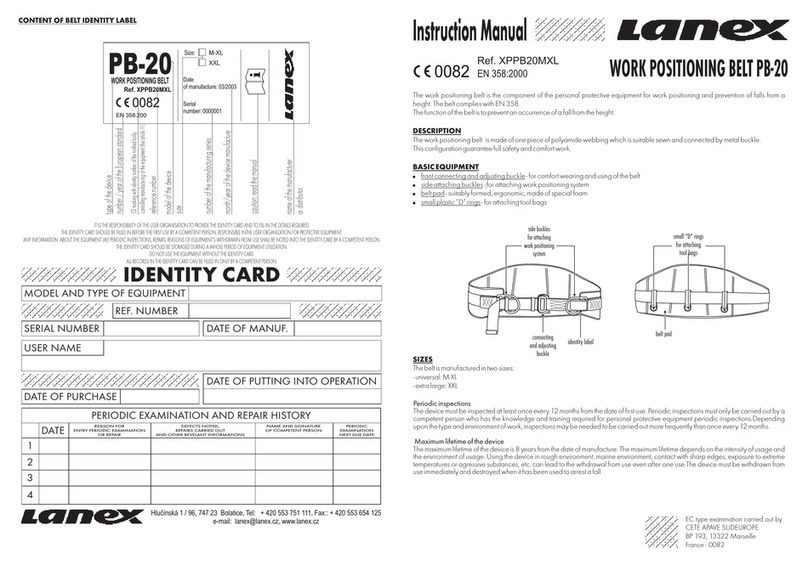
Lanex
Lanex PB-20 instruction manual
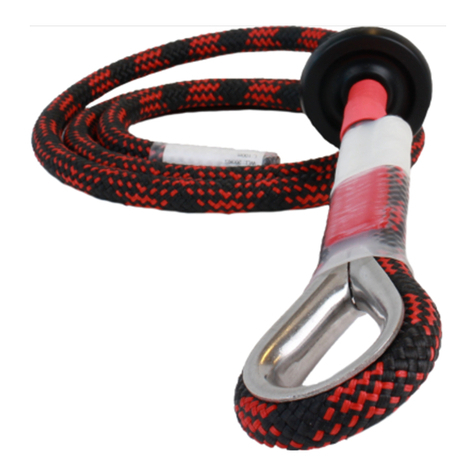
SKYLOTEC
SKYLOTEC ANCHOR ROPES Instructions for use

Besto
Besto Buoyancy Aid 50N Instructions for use

TEUFELBERGER
TEUFELBERGER NODUS Manufacturer's information and instructions for use

Troy Lee Designs
Troy Lee Designs Tbone Product owners manual
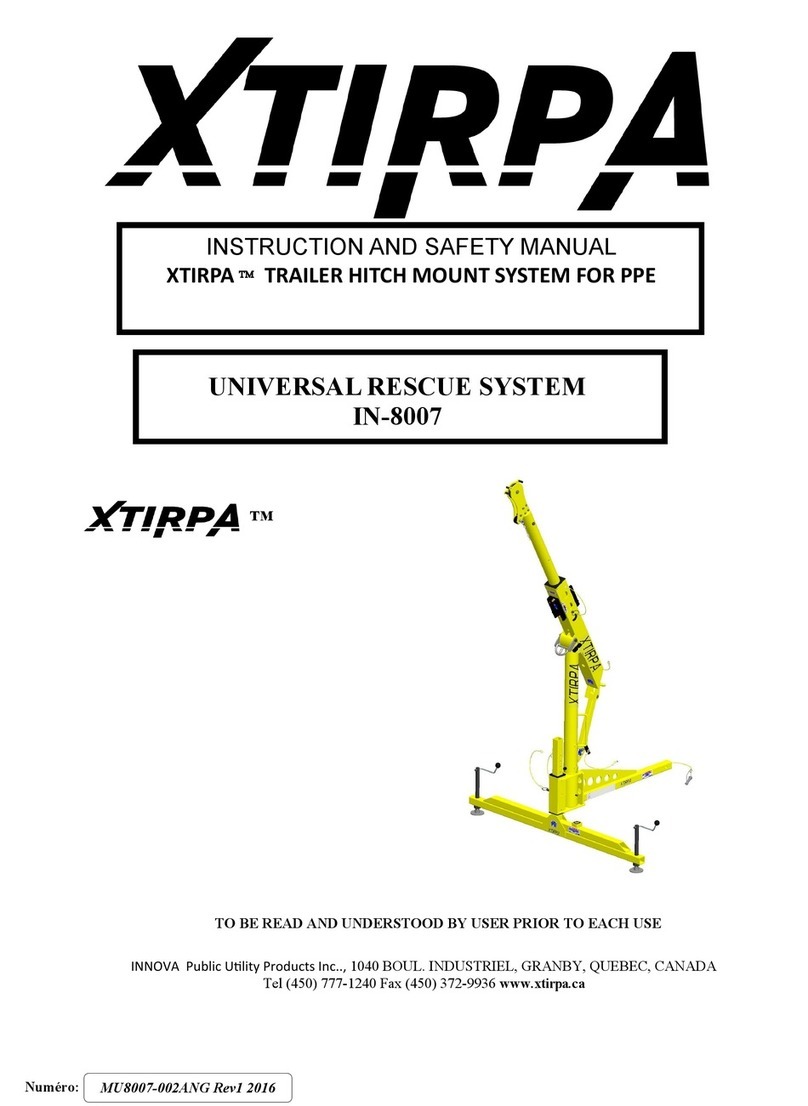
Innova
Innova Xtirpa Instruction and safety manual

bolle SAFETY
bolle SAFETY B810 quick start guide
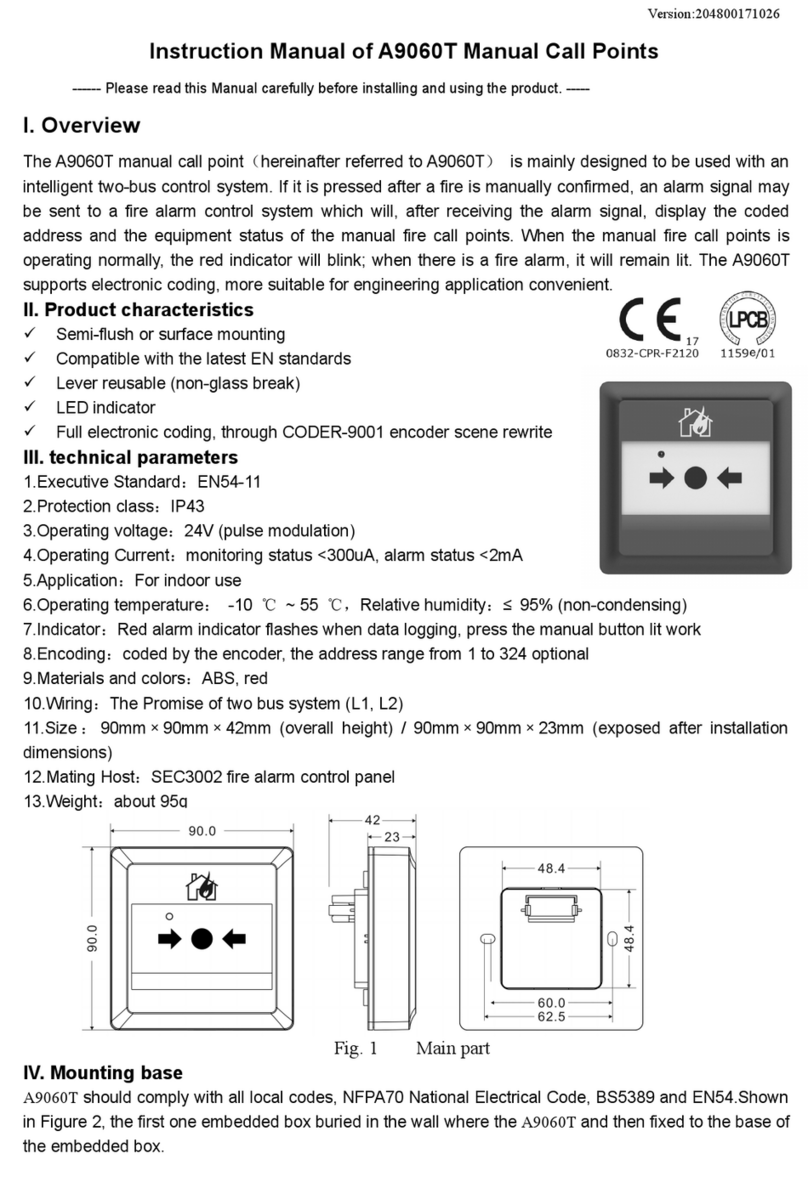
SHENZHEN FANHAI SANJIANG ELECTRONICS
SHENZHEN FANHAI SANJIANG ELECTRONICS A9060T instruction manual
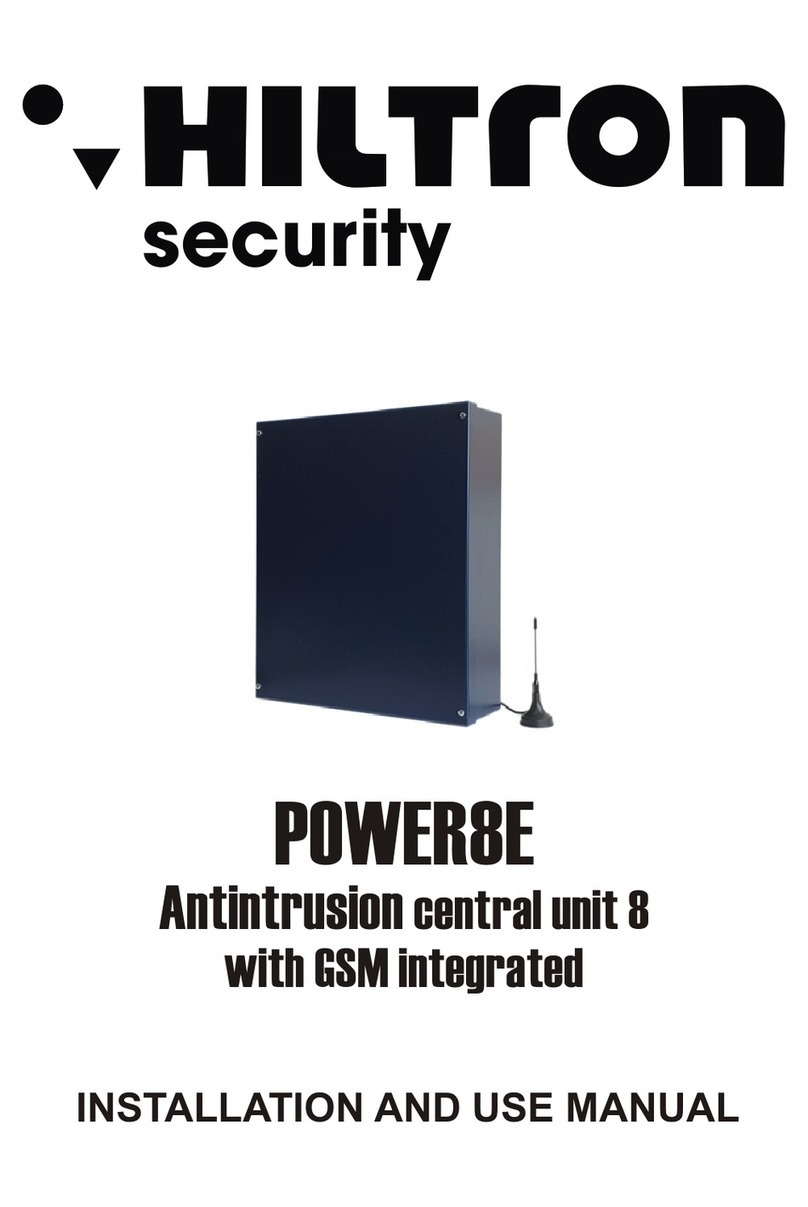
Hiltron security
Hiltron security POWER8E Installation and use manual

Salewa
Salewa MTN SPIKE user manual
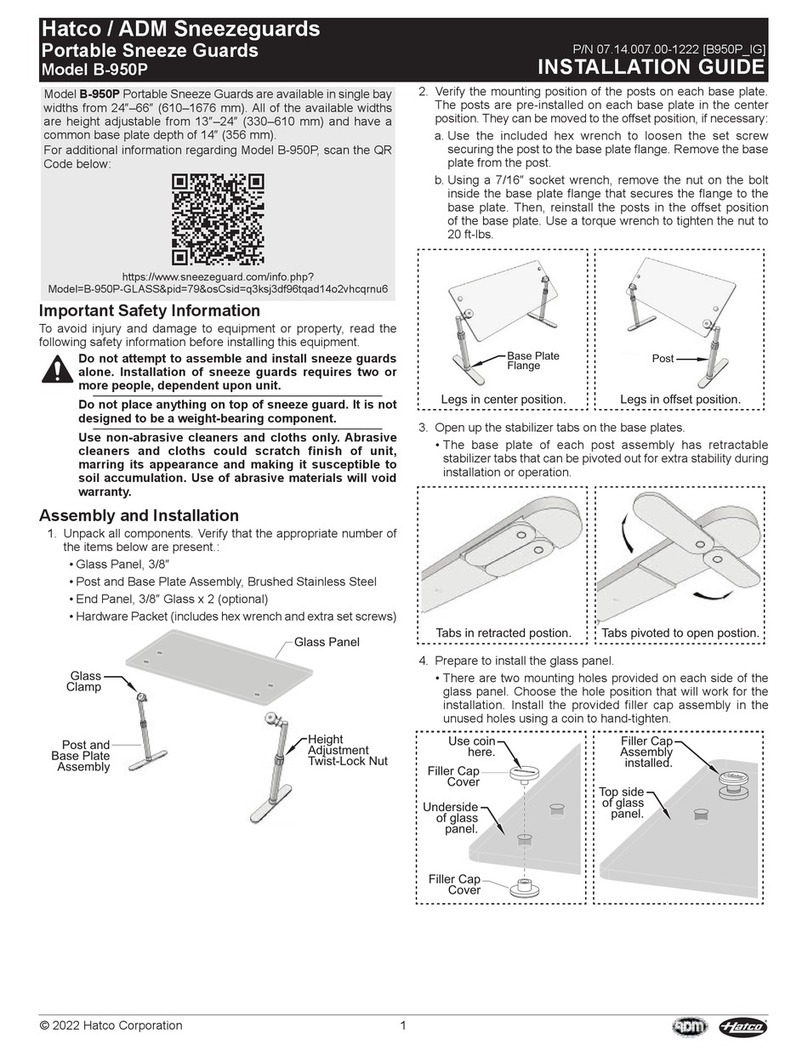
Hatco
Hatco B-950P installation guide
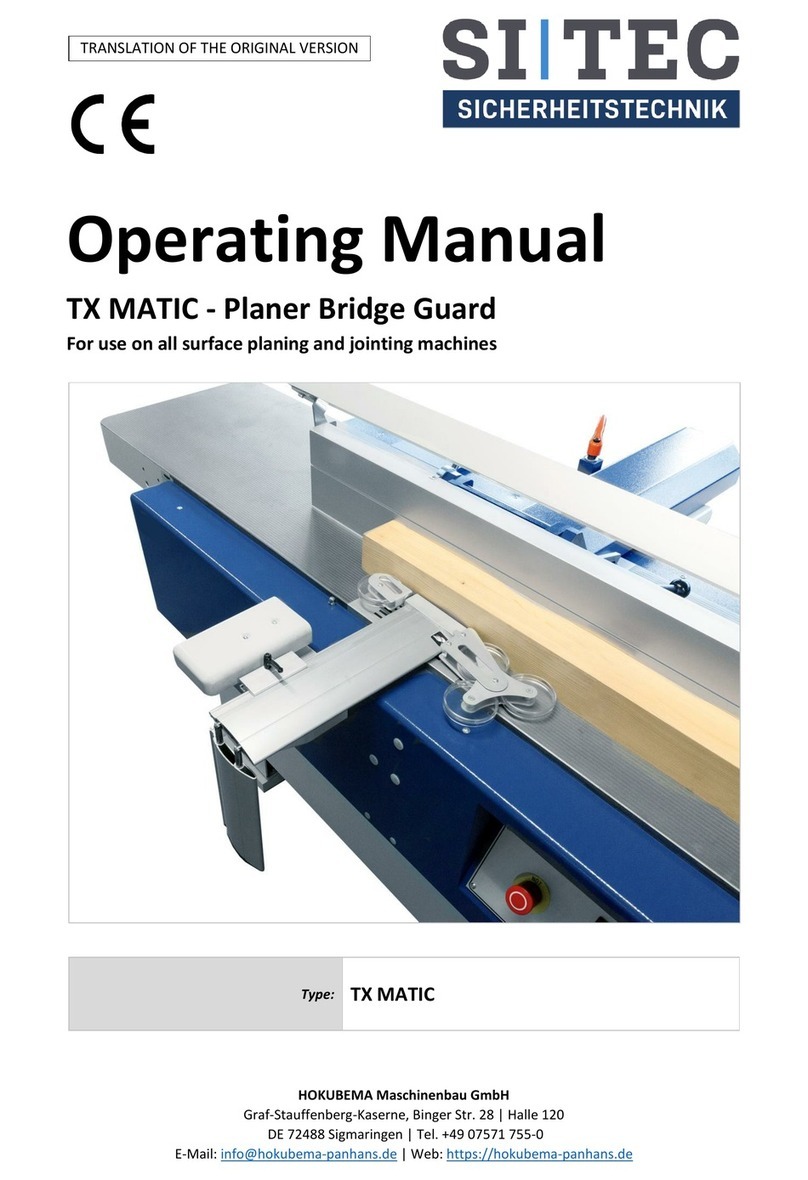
Sitec
Sitec TX MATIC operating manual
